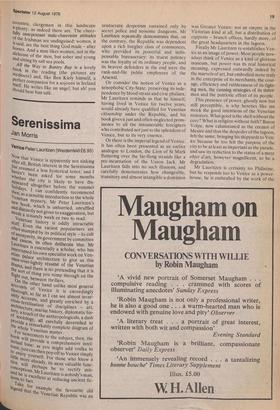Serenissima
Jan Morris
%lice Peter Lauritzen (Weidenfeld £6.95) Now that Venice is apparently not sinking after all British interest in the Serenissima has resumed a less hysterical tenor, and I haven't been asked for some months whether the city is likely to have disappeared altogether before the summer holidays. I can confidently recommend ,then, as a sensible introduction to the whole Venetian mystery, Mr Peter Lauritzen's Pew book, which is unhurried, unruffled and distinctly not given to exaggeration, but needs a leisurely week or two to read. Venetian history is oddly intractable stuff. Even the raciest popularisers are often stumped by its political style — its cult of anonymity, its government by committee and caucus, its often deliberate blur. Mr Lauritzen is essentially a scholar, who has interrupted his own specialist work on Venetian palace architecture to give us this once-over-lightly resume of the Venetian d,rarna, and there is no pretending that it is the sort of thing you romp through on the flight out, between thrillers. On the other hand unlike most general accounts of Venice it is exceedingly thorough
, ,
so far as I can see almost invariably accurate, and greatly enriched by a cross-fertilisation of disciplines — art, architecture, marine history, diplomatic history, a touch of the anthropologicals, a dash or sociology, all carefully dovetailed to Provide a remarkably complete diagram of the whole Venetian matter. b For newcomers to the subject, then, the provide a comprehensive intellectual base: as you might add vodka to ticMic, you can then pop off to Venice simply lttle enjoy yourself. For those who know a more already, its most valuable func_I°P will perhaps be to rectify miscaonneeptions. Mr Lauritzen is nobody's man, d he is excellent at reducing ancient ficLions. 1o fact.
Take for example the favourite old I egend that the Venetian Republic was an aristocratic despotism sustained only by secret police and noisome dungeons. Mr Lauritzen repeatedly demonstrates that, on the contrary, the Republic was dependent upon a rich burgher class of commoners, who provided its powerful and indispensable bureaucracy: its truest potency was the loyalty of its ordinary people, and its bravest defenders in the end were the rank-and-file public employees of the Arsenal.
Or consider the notion of Venice as a xenophobic City-State, preserving its independence by blood-strain and civic phalanx. Mr Lauritzen reminds us that he himself, having lived in Venice for twelve years, would already have qualified for Venetian citizenship under the Republic, and his book gives a just and often-neglected prominence to all the innumerable foreigners who contributed not just to the splendour of Venice, but to its very essence.
Or there is the imperial legend of Venice. It has often been presented as an earlier analogue to London, the Lion of St Mark fluttering over the far-flung strands like a pre-incarnation of the Union Jack. Mr Lauritzen falls into no such illusions, and carefully demonstrates how changeable, transitory and almost intangible a dominion was Greater Venice: not an empire in the Victorian kind at all, but a distribution of outposts — branch offices, hardly more, of the great headquarters in the lagoon. Finally Mr Lauritzen re-establishes Venice as an image of power. Most people nowadays think of Venice as a kind of glorious museum, but power was its real historical meaning, expressed outwardly indeed by the marvels of art, but embodied more truly in the enterprise of its merchants, the courage, efficiency and ruthlessness of its fighting men, the cunning strategies of its statesmen and the patriotic effort of its people.
This presence of power, ghostly now but still perceptible, is why heretics like me mock the good intentions of the Venetian restorers. What good is the shell without the core? What is religion without faith? Baron Volpe, now calumniated as the creator of Mestre and thus the despoiler of the lagoon, felt the same, bringing his shipyards to Venice because he too felt the purpose of the city to be at least as important as the parade, and saw its reduction to the status of a mere objet d'art, however magnificent, to be a degradation.
Mr Lauritzen is certainly no Philistine, but he responds too to Venice as a powerhouse, he is enthralled by the work of the Venetian shipwrights, banks and traders, and he rightly emphasises in the last paragraph of his book that one cannot understand the physical masterpiece that is Venice without grasping the causes of its glory — the national purpose, for good or evil, which gave this city its impetus and its style. Venice is not a simple subject, not just a lovely spectacle to be saved from decay by the judicious application of charitable funds. It is an idea too, and a sense of ancient conviction, and a civic machine. Mr Lauritzen will have done his adopted city proud, if he persuades a few more Englishspeaking visitors to think of the old place not just as a paradise for dilettantes and benevolent amateurs, but a metropolis that hard minds made, brave hearts consolidated, and diligent professionals made beautiful.































 Previous page
Previous page